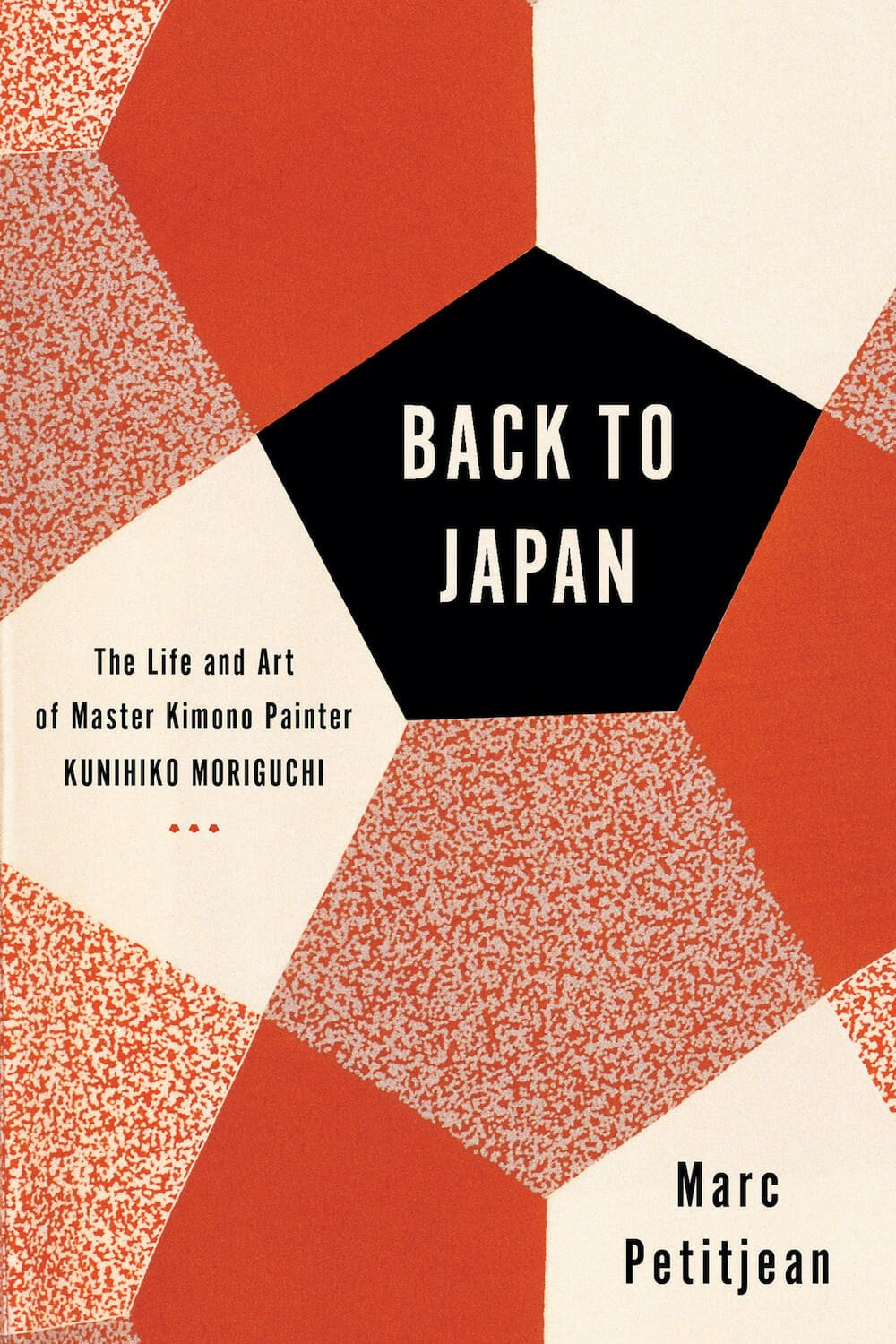"Cut-glass droplets of light hung from the ceiling, and armchairs were arranged like petals around circular tables on carpeting in a checkerboard of warm colors. The walls were clad in pale wood and the views softened by paper screens. From a distance I watched the female staff elegantly going about their work in their pastel-colored kimonos… Kunihiko Moriguchi came to greet me with a broad smile."
In the Orchid Bar of the now-demolished Hotel Okura Tokyo, so begins the friendship of two artists – writer and filmmaker Marc Petitjean, and kimono painter Kunihiko Moriguchi. They meet for a drink, but their conversation about Japanese culture and art resonates so much with the former that he tells Moriguchi he’d like to make a film about him and his work.
Petitjean continues: “Back at my hotel I leafed through the catalogue of his painted kimonos. I was expecting branches of cherry blossom, waves, pagodas. Instead I discovered geometric patterns in incrementally fading colors that sublimated the very notion of kimonos.”
As we delve into Moriguchi’s history, we learn about his studies abroad in Paris, where he was influenced by the Op art movement of the 1960s, as well as a network of European artists with whom he developed long-lasting creative and personal relationships. It is within these differences – the pull Moriguchi feels between east and west, Japan and France, tradition and modernity – that he finds the driving tension of his art, and where Petitjean establishes the crux of his friend’s story.
In Back to Japan: The Life and Art of Master Kimono Painter Kunihiko Moriguchi, author Marc Petitjean details his friend’s journey as an artist – from his identity as the son of a kimono painter, his meticulous craftsmanship and work ethic as a student in Paris, to his whirlwind life within the glamor of European art circles – and how, at the outset of what could have been an illustrious design career in Europe, he chooses instead to move back to Japan, and carry on the craft of kimono painting from his father, all the while integrating the artistic styles and design principles that he’d picked up during his studies abroad.
BACK TO JAPAN Details the Life and Art of a Master Kimono Painter
Using accounts from friends, family, peers, and Moriguchi himself, as well as his own observation and summary, Petitjean traces a line through the events and influences that led up to Moriguchi’s career as a master kimono painter and designation, in Japan, as a Living National Treasure.
In one passage, for example, he recounts an exercise in gradation from Moriguchi’s days as a graphic design student at the École des Arts Decoratifs:
“On sheets of paper fifty centimeters square they had to draw about one hundred parallel lines with a ruling pen, spacing them progressively farther apart. [Moriguchi’s classmate] remembers this as an ordeal… ‘The only person who could draw those lines reliably, firmly, and regularly was Kuni, and I asked him how he could concentrate so hard. He said, ‘It’s all in the breathing. You hold your breath and work without breathing.’”
Petitjean presents a number of such anecdotes from Moriguchi’s past – others include memories of his father being forced by the military to halt operations in his workshop and instead produce “decoy aircraft in wood and fabric, to mislead American pilots,” during WWII; and that of a Balthus painting of a room Moriguchi stayed in at the Villa Medici in Rome – the patterned tiling and fabric of which later inspired some of his kimono designs.
This writer found each detail to be a fascinating revelation, especially within the context of Moriguchi’s trajectory as an artist. You, too, might find satisfaction in seeing how the events and idiosyncrasies of his youth pave the way for his later works.
Another highlight are the detailed breakdowns of how Moriguchi constructs his patterns, and creates the illusion of movement by repeating and disrupting geometric shapes. Those interested in the creative decision-making process behind works of art and craft will likely find great interest in the insights Petitjean draws from his subject, regarding his specific works and stylistic vision at large.
Petitjean’s elegant descriptive language and his elevation of small details and subtleties make this book a pleasure to read, even when its focus trails to more peripheral scenes and cultural analyses. However, one shortcoming, in this writer’s view, is the lack of accompanying visuals. As you read you might feel compelled to do your own online research in order to aid your understanding of Moriguchi’s work. The few black and white images that are included do little to depict the full scope of his kimonos’ detail, body and color. As such, it is easy to miss out on the beauty of his designs, and the distinct qualities that set him apart as a kimono painter and make for the basis of his legacy.
Back to Japan is recommended for anyone with an interest in traditional Japanese art, culture and philosophy. It is more specifically recommended to those interested in textiles and pattern-making, and readers with a curiosity about the personal history, motivations, and philosophies that underlay a finished work of art.
RECOMMENDED
Price: $13.99 (E-book), $25 (Hardcover)
Click here for more information on BACK TO JAPAN.
Images courtesy of Other Press
Nominate this for The Picture This Post BEST OF 2021???
Click Readers' ChoiceWant to see who won the Picture This Post READERS’ CHOICE competition last year?
WATCH THIS SHORT VIDEO—
Looking for more good reads? Watch this short video of our picks of BEST BOOKS — and visit our roundup of
Highly Recommended Books from Picture This Post--

About the Author: Lily LeaVesseur
Lily LeaVesseur has harbored a fondness for the arts since she was a few months old, when her parents took her on her first of many stroller rides through the halls of the Art Institute of Chicago. Even after moving to San Diego as a child, she returned many times so that she could stare down her favorite pieces, combing them over again and again for clues to their greatness.
She carried this enthusiasm like a missionary, and in high school petitioned to re-open the single Art History course on the roster so that she could study it with her friends. She loved feeling like she could unlock some sort of intangible mystery behind works of art, and looking for herself within the artists that created them.
Since then Lily has continued to explore art both analytically and creatively. She now writes poetry and non-fiction, sometimes accompanied by illustrations or watercolor, and hopes to one day collect these works into a graphic novel. When she's not writing or drawing, she can otherwise be found skating with friends, experimenting with new food combinations, and/or lying on the floor contemplating the transcendental nature of TikTok.




